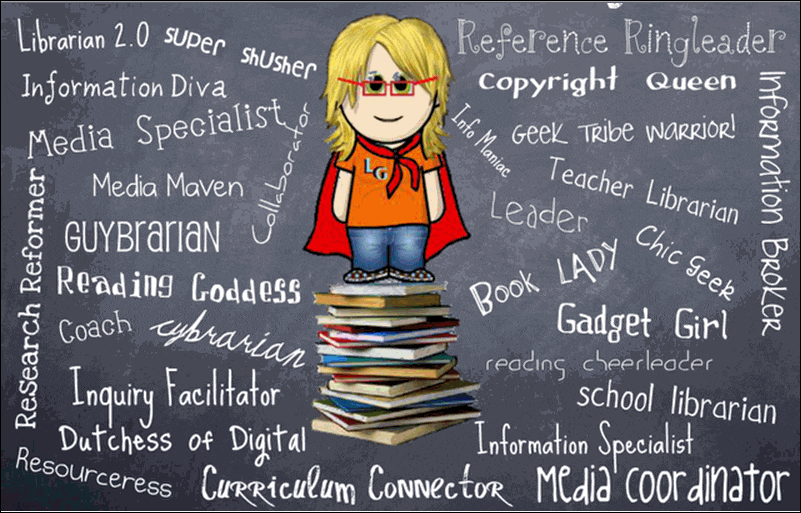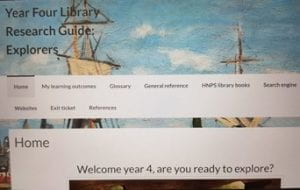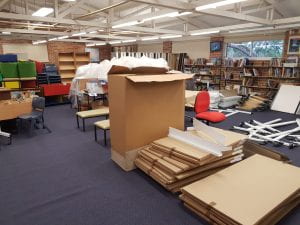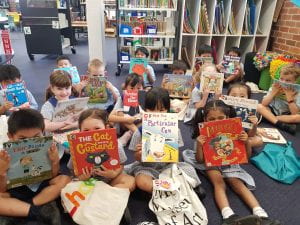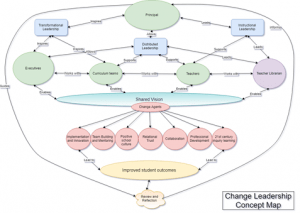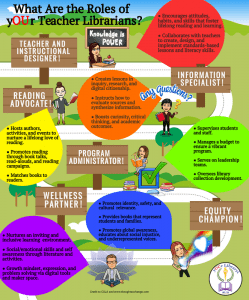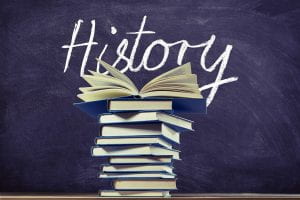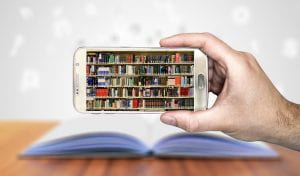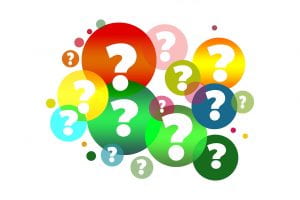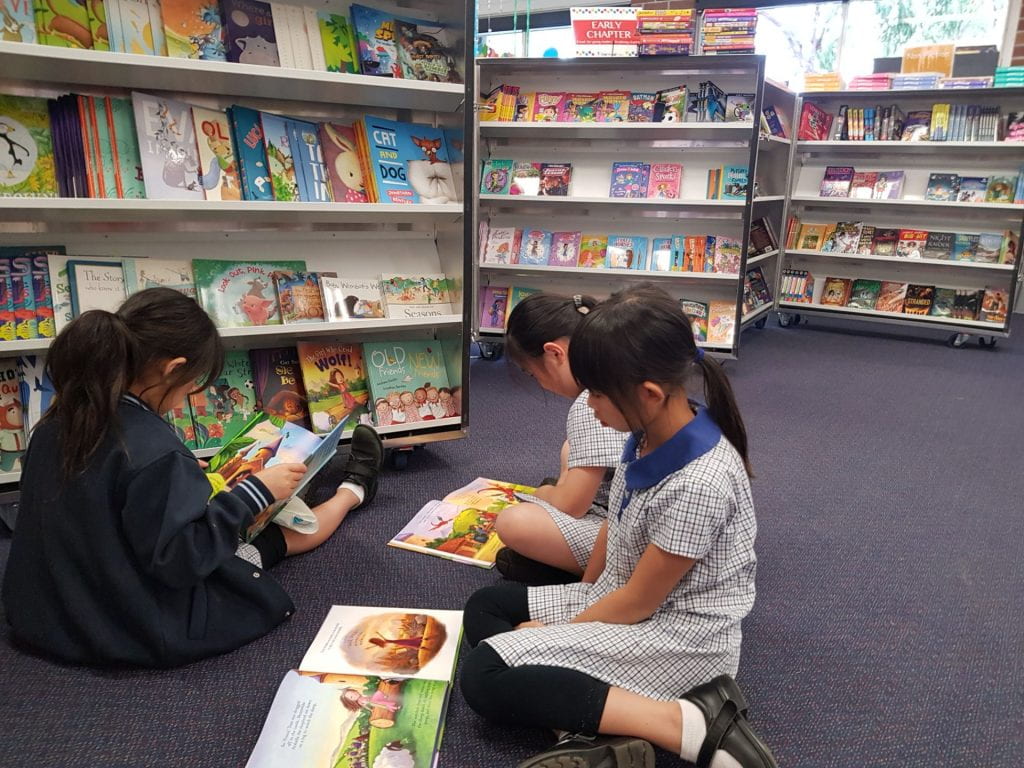Final Reflective Portfolio
Part A
Personal philosophy: What do you think makes an effective teacher librarian (TL)?
An effective teacher librarian (TL) is creative and adaptable in the support she gives students and colleagues. A strong and consistent school-wide promotion of the importance of literacy, reading, knowledge, inquiry, and creation is essential. This is demonstrated through leadership as an information professional and extensive collaboration with teachers and students in the areas of curriculum, content curation, literature support, and digital literacy. TLs are also creators of unique and inviting spaces to promote learning, inspiration, and safe havens to explore and escape into a story. More importantly, TLs know their communities. They learn the nature of their students’ likes and interests and their teachers’ preferences, and teaching styles. The graphic above lists a myriad of roles a TL performs in a school but Joyce Valenza (2013) in her list of what we will lose if TLs are taken away, also reveals what we can gain from continuing to properly fund and support school libraries.
Part B

Free-Photos / Pixabay
This section is divided into three major themes identified as significant areas of learning in the Master of Education (Teacher librarianship) course. The themes I have chosen are technology, collection development and literature, and leadership.
Theme one: Technology
Information and communications technology (ICT) is central to education and school libraries. Grantham (2007, p. 5) states that students will see libraries as irrelevant if TLs do not harness the capability of new technology. She goes on to describe two types of guidance that are crucial.
- Proficiency in 21st-century information skills and,
- Well-designed online environments.
Every day in my work as a primary school library teacher, technology as a tool, guides my work and the explorations of my students. It also provides the opportunity to manipulate and share information using web 2.0 tools. This ability to gather information, then share it has become central to ICT in school libraries. In this respect I have endeavoured to increase collaboration in library ICT tasks.
ETL501 and ETL402 both presented a myriad of possibilities in quality online tools.
In the last eighteen months our library has gained a set of 30 laptops in addition to the 30 ipads that are shared between library and our French and Italian teachers. 1:1 access for our students has enabled me to up-level our digital and information literacy programs from a rudimentary level to a more sophisticated list of skills. Rather than stand-alone lessons, these information literacy skills are integrated into units of work that support classroom units of work. ETL501 – The Dynamic Information Environment, was key in developing more sophisticated search strategies and website evaluation and exploring web 2.0 tools to enhance student engagement and learning. My assessment reflection Nicklin, (2020, September 26), explains this further. However, the release from face to face (RFF) structure for library lessons downplays the significance of our value. I continually advocate by ‘muscling in’ on grade meetings and communicating with grade coordinators formally and informally to promote my value in a primary school library. An example of informal advocacy I have implemented is to mention a significant moment that occurred during the lesson such as an astute observation by a student. This small measure while teachers pick up classes from library lessons, along with building up communication and consistent support, will strengthen the foundations of advocacy.
For the first assessment in ETL501, I wrote a proposal to the principal for the development of a library website to support the community. A carefully curated library virtual website will increase our connection with the school community and broaden the landscape of authentic 21st education. A virtual website’s purpose is to create confident, active and informed citizens who are successful learners (Australian Curriculum, Assessment and Reporting Authority, n.d. para 1). However, this website is still a work in progress. During lockdown in 2020, I created a basic Google Site for the library, but I was neither satisfied with the outcome nor felt it offered enough content to be useful for our school. Gambrell (2015, December 8) suggests seven simple considerations to maximise student successful usage of a library website. The challenge for me is to create a site that is navigable by five- and six-year-old students to ensure the entire school will achieve search success for information. By referring WAG 2.0 guidelines, I will ultimately support all users and covers the broad range of accessibility tools to create an inclusive site.
The second assessment to create a pathfinder for a unit of work was immensely satisfying as I had a group of teachers and students, I tailored the pathfinder for a year four class. My explorer’s pathfinder for Stage 2 was useful for teachers and students and provided a starting point for the unit. It was immensely satisfying to support staff and students digitally having just returned to school after online learning during a Sydney lockdown in March/April 2020.
Year 4 research guide 2020. Created by D. Nicklin
This gave me the confidence to look at further pathfinders to integrate with grades. Levitov (2015, p. 4), states that TLs must embrace leadership in their role as information professionals requiring active visibility. This was demonstrated in the teacher and student use of these pathfinders and has directly improved student information literacy skills and visibility of the TLs role.
New to me was the idea of blogging in a primary school setting. However, the use of my own blog to complete this degree has demonstrated the effectiveness of the space to teach critical and digital literacy. Sheko (2019), describes the elasticity and stretchiness of the TL role and encourages libraries to experiment with blog spaces. My blog post (2020, August 24), further lists examples of blog usage for our library. My colleague (who is about to return from maternity leave) and I are in the planning stages of creating a blog for stage three students to share and promote literature they have enjoyed. We are building into this the importance of online etiquette when sharing a digital space as well as giving students a real readership rather than just their teacher.
I will continue to improve my use of digital tools to keep our library relevant in an increasingly digital world. Students and teachers are rapidly upskilling themselves digitally in our current situation of a Sydney lockdown in July 2021. My challenge is to keep up with an ever-increasing role description list, and an ever-changing learning environment. The Master of Education (Teacher Librarianship) course has opened the door and given me a map to achieving this ideal.
Theme two: Collection development and literature.
This is an increasingly complex area in my work. Fulfilling
 the requirements of meeting the needs of the community in which I work on a limited budget is challenging. Johnson, Huille & Reed (2009. P. 103), suggest TLs need to be increasingly selective due to the vast numbers of literature that is published each year. ETL503 demonstrated the importance of creating a collection development policy to guide management in this respect and explored the need for inclusivity of several factors. Diversity, reading levels, censorship, disability guidelines, curriculum focus, digital literacy, appropriateness, relevance, durability, and reading freedom are a few of the significant considerations. Narrowing down selection within a budget has become an ongoing series of compromises. There was no collection Development Policy at the library where I work, so I embarked on the daunting task with the support of the principal. I have recently revisited this document to update inclusions relevant to a lockdown scenario.
the requirements of meeting the needs of the community in which I work on a limited budget is challenging. Johnson, Huille & Reed (2009. P. 103), suggest TLs need to be increasingly selective due to the vast numbers of literature that is published each year. ETL503 demonstrated the importance of creating a collection development policy to guide management in this respect and explored the need for inclusivity of several factors. Diversity, reading levels, censorship, disability guidelines, curriculum focus, digital literacy, appropriateness, relevance, durability, and reading freedom are a few of the significant considerations. Narrowing down selection within a budget has become an ongoing series of compromises. There was no collection Development Policy at the library where I work, so I embarked on the daunting task with the support of the principal. I have recently revisited this document to update inclusions relevant to a lockdown scenario.
- 2. Library reshelving. 2019. D. Nicklin
Our library in 2019 held many outdated titles in poor condition. This was particularly the case with the non-fiction collection. Examples of books on a particular country from before the year 2000 were plentiful and searching the loan history in Oliver revealed these titles were infrequently loaned if at all. New shelving in 2019 was the perfect opportunity to extensively and ruthlessly weed the entire collection. Unfortunately, this occurred before I studied ETL503, therefore my weeding was somewhat ad hoc. Titles in poor condition, those not loaned in the last two years and a non- appealing appearance only went part-way to properly evaluate each item. ETL503 has highlighted so many more considerations detailed in my reflection (2020, January 23).
My understanding of the two concepts of literature and literacy have deepened considerably. ETL402 provided a broad and succinct appreciation of the intrinsic value of literature and literacy in education. It’s generally accepted that reading is important for education and pleasure, however, Barone (2010), aptly describes below the true value of reading,
“When teachers cultivate reasons for reading, children move beyond the single focus of deciphering print. Their interactions with literary language and images in books support creativity, connections, and criticism as they participate in conversations centred on them. (p. 5).”
It is not simply good enough to buy books, accession them and plonk them on the shelves. Neil Gainman (2016), an author of many books for adults and children encourages us to shift our thinking and he promotes libraries as not places with shelves of books, but places of freedom. As TLS we are in a unique and privileged position to show students the truth of these words and to reveal the power that literature and literacy have for all their futures.
Students have access to a wide range of texts in our school library; however, the enthusiasm varies when they walk in. While some rush to the new books shelf, others dawdle around and linger with their hands in their pockets. If a Minecraft book isn’t available, they say, “I can’t find anything I want.” These students are my greatest challenge. Donalyn Miller (2013, October 10), describes in the video below how she attempts to create lifelong readers, rather than simply good readers.
3 Donalyn Miller (2013, October 13). reading in the wild.
After reading her book, Miller inspired me to look for reasons why these students opt out of literature. I have conversations with these students during borrowing time and look for an interest or a spark of enthusiasm. I realise that encouraging them to read is far more significant than what they are reading. I order more ‘low brow’ texts if it means that these students show an inkling of interest in reading at all. A small number of staff say some books such as Captain Underpants should not be on school library shelves! This goes against the concept of freedom to read.
Book promotion, displays, reading aloud and immersion in stories are important roles of a TL. However, with experience, I find allowing students to share their enthusiasm and passion for literacy is one of the most powerful drivers of encouragement. Student promotion via book trailers, book bentos, and conversations around story are powerful influencers to engaged and un-engaged readers.
- 5. Students borrowing at HNPS. (2020)
Our school is in a diverse area of Sydney so awareness of inclusivity, cultural literacy, and cultural schema (Ross-Johnson, 2014, p. 536) have been a focus. A collection review comparing the school population and the diversity of the collection showed a dominance of Anglo-Saxon characters and ideologies. With guidance from ETL503, I was able to include a statement within the Collection Development Policy to raise awareness of cultural literacy and balancing the collection to reflect the current student population. My growth in this area is enormous. I feel our collection continually moves from a general assemblage of titles to a more curated and appropriate collection for our community. My next challenge is to increase the bi-lingual books available.
Theme three: Leadership
The idea of leadership in a school library context was an idea not considered by me. Judy O’Connell introduced this idea in ETL401 in module 3. A pivotal article by Bonanno (2015), opened my eyes to the advocacy role TLs must take to “play it forward.” (Bonanno, 2015, p. 20). This means to advocate for the absolute importance of the role the school library and its staff have in outcomes by students in a variety of literacies. I admitted in my blog post (2019, July 15), that leadership was creeping up on me in my new role as a primary school TL. Experience was and continues to teach me that Bonanno’s emphasis in her article is a large part of our role, particularly in a school library environment.
ETL504 defined leadership and the various styles that are present in organisations. The first assessment task challenged me to locate the leadership style and role a TL holds within a school situation. Creating a leadership map was a very difficult task and challenged me to consider the viewpoints of the whole school community.
I had no role model to emulate in my limited library experience. Additionally, all the staff I worked with had no leadership expectations of me. Goslin, K. (2011, January 18). The video below describes seven practical steps to affect change within an educational organisation. With this roadmap in hand, along with many readings in the modules, I was able to begin to re-position the library and its unique value to the community.
This new mindset has adjusted how I advocate for the services our school library provides. However, this process is long and arduous. At times it resembles an uphill battle and with a combination of subtle and not-so-subtle methods, I am making in-roads. A current example is to add Wheelers Eplatform to our collection in addition to another online eBook platform we have. World Book Online provides good access to non-fiction titles with a few fiction titles. However, the current lockdown in Sydney in 2021 has greatly limited our students access to fiction books. Ultimately, my goal is to increase staffing. I have no library assistant, which ties me to daily administrative tasks such as shelving, weeding, and accessioning. In a small school this would be expected, however, in a primary school of nearly one thousand students, a vast majority of my time is administrative.
The leadership styles explored in ETL504 allowed me to reflect on my experiences working in schools. Bush & Glover (2014), clearly highlight the significance of leadership styles on student learning and the moral of staff in response to leadership styles. I resonated with the following statement:
“Leadership is a process of influence leading to the achievement of desired purposes. Successful leaders develop a vision for their schools based on their personal and professional values. They articulate this vision at every opportunity and influence their staff and other stakeholders to share the vision. The philosophy, structures and activities of the school are geared towards the achievement of this shared vision.” (Bush and Glover 2003, p. 5)
The leadership theories described in ETL504 apply to a variety of roles in a school, however, not all apply to the role of TL. The phrase ‘leading from the middle’ was used widely by Jennie Bales and students in comments in the discussion forums, particularly to describe TLs. This equated particularly with the theories of servant and instructional leadership. Greater experience in the TL role and changing teaching and learning circumstances with lockdowns, has opened the opportunity for me to practice leading from the middle. This Master of Education (Teacher librarianship) course has allowed me to understand the nature of leadership, and the impact of the differing styles of leadership. Instructional leadership is increasing as I help some of my colleagues locate resources and navigate the home learning platforms of Seesaw and Google Classroom. I am no expert, but a different lockdown workload for some of our classroom teachers is causing much anxiety. They feel they are being left behind in a technological world. I have been able to step up and gently help these teachers with the technology support that the executive are overlooking.
7https://www.yourdigitallibrary.org/about-us.html
Practically, to engage in many of the more significant and more visible avenues of leadership studied in ETL504 is quite beyond the staffing and time constraints in my current school. I suspect it is outside the realms of most NSW Department of Education. An overloaded class load and full library administration responsibility at a large primary school equate to constant prioritisation. This leaves me with too many obligations. Therefore, I need to be efficiently strategic to achieve and advocate for aspects of my role as shown in the graphic above (yourrdigitallibrary.org. n.d.).
Part C
The Standards for Professional Practice of Teacher Librarians (2004), outlines the highest standards to which all TLs should aspire. These guidelines can be adapted to a variety of school library circumstances and are appropriate for K-12.
The Master of Education (Teacher Librarianship) course at Charles Sturt University (CSU), has supported me significantly in all three of the areas. At the commencement of this course, I had a rudimentary notion of the TL role, and was unaware of the depth and scope possible. The guidelines are a place to measure my current practice. Also, a place to identify areas I need to improve and work on. My practice has improved immensely over the last few years however I feel that I have a while to go before ‘excellence’ can describe my practice.
Standard 1: Professional knowledge
Standard 1.4-knowledge of library and information management is particularly significant to my learning. My understanding of how the library fits into the context of the whole school and its significant contribution of information literacy has changed my emphasis in my role as TL. Further work for me is to refine our information literacy scope and sequence further and to ensure I keep up with current practice and techniques. Journals such as SCAN and belonging to professional associations will achieving excellence. This standard is the area in which this course has supported me the most. The scope and depth of content across the subjects I studied and chose has prepared me significantly. I am better prepared for the nature of the role in a school context and the study visits have demonstrated the scope of the information industry.
Standard 2: Professional practice
I work in a primary school library which is advantageous to achieve these goals. I was able to immediately consider how to improve practice and locate areas that are lacking. Such as reviewing my programs and identifying areas of improvement. An area for me to continue to improve is my use of ICT in programs. I am beginning to use web 2.0 tools, however there are more opportunities to explore in this area. Applying theory to my practice has resulted in improved outcomes, but this needs to further develop. Collaboration is another opportunity for me to improve in the future. ETL504 has supported my confidence and knowledge to advocate for our library and to spruik our value via different styles of leadership.
Standard 3: Professional commitment
Advocates such as Donalyn Miller and her passion for the absolute necessity for a lifelong love of reading have inspired me. Through careful collection development, reading promotion and a consistent approach to literacy, I now have a 21st century collection of tools to raise outcomes. The principles and underpinning theories I’ve learned in this course support me to confidently realise the unique place of the TL and the library in the school. I also now understand how my role is to support and work with others to create a collegial community of practice who work towards the same vision.
I have reached the end of this course a far better TL and I have broadened my perspective on every aspect of my daily practice in a school library. I will continue my learning journey towards excellence as a TL and I am grateful for every opportunity the Master of Education (Teacher Librarian) has provided me.
References
Australian Curriculum, Assessment and Reporting Authority. (ACARA). (n.d.). Learning areas. https://www.australiancurriculum.edu.au/f-10-curriculum/learning-areas/
Australian Library and Information Association and Australian School Library Association. (2004). Standards of professional excellence for teacher librarians. https://read.alia.org.au/alia-asla-standards-professional-excellence-teacher-librarians
Barone, D. M. (2010). Children’s literature in the classroom : Engaging lifelong readers. ProQuest Ebook Central https://ebookcentral.proquest.com
Bonanno, K. (2015). A profession at the tipping point. https://kb.com.au/content/uploads/2015/03/profession-at-tipping-point2.pdf
Bush, T. & Glover, D. (2014). School leadership models: what do we know? School Leadership & Management, (34)5. pp. 553571, DOI: 10.1080/13632434.2014.928680
Gaiman, N. (2013, Oct 16). Why our futures depend on libraries, reading, and imagination. The Guardian. (Australian Edition). http://www.theguardian.com/books/2013/oct/15/neil-gaiman-future-libraries-reading-daydreaming
Gambrell, K. (2015, December 8). 7 best practices for creating a user-friendly library website. Ebsco. https://www.ebsco.com/blogs/ebscopost/7-best-practices-creating- user-friendly-library-website
Goslin, K. (2011, January 18). Instructional leadership for 21st century changes in teaching and schooling. [YouTube]. https://youtu.be/H-lkQF4vhCc
Grantham, C. (2007). Virtual library: e-ssential. Access (10300155), 21(3), 5–8. http://web.b.ebscohost.com.ezproxy.csu.edu.au/ehost/pdfviewer/pdfviewer?vid=1&sid=2a6176fc-8a6f-4c6b-9f52-beb8fc6527d9%40pdc-v-sessmgr02
Johnson, P., Hille, J., & Reed, J. A. (2005). Fundamentals of collection development and management. ProQuest Ebook Central https://ebookcentral.proquest.com
Just call me library girl. (2014). [Image]. Flickr. http://2.bp.blogspot.com/- HyxvI4md288/Tb4XqL1fmrI/AAAAAAAAAMo/DvN6Rb3dP1U/s1600/Just+Call+Me+Library+Girl.png
Levitov, D. (2015). Leadership Is Necessary. School Library Monthly, 31(5), 4. http://web.a.ebscohost.com.ezproxy.csu.edu.au/ehost/pdfviewer/pdfviewer?vid=3&sid=9d067ed6-b36b-4db1-af99-aa19932f1332%40sdc-v-sessmgr03
Nicklin, D. (2019, July 15). Leadership thoughts. [Blog post]. https://thinkspace.csu.edu.au/debnicklin/2019/07/15/leadership-thought/
Nicklin, D. (2020, January 23). ETL503 Assessment 2: Reflective practice. [Blog post]. https://thinkspace.csu.edu.au/debnicklin/2020/01/23/etl503-assessment-2-reflective- practice/
Nicklin, D. (2020, August 24). Explore the Edublogs site and identify a way you could use a blog in the school library or classroom. Discuss and reflect on your Thinkspace. [Blog post]. Deborah’s reflections. https://thinkspace.csu.edu.au/debnicklin/2020/08/24/explore-to-the-edublogs-site-and-identify-a-way-you-could-use-a-blog-in-the-school-library-or-classroom-discuss-and-reflect-on-your-thinkspace/
Nicklin, D. (2020, September 26). ETL501 A2: Part B critical reflection [Blog post]. Deborah’s reflections. https://thinkspace.csu.edu.au/debnicklin/2020/09/26/etl501-a2-part-b- critical-reflection/
Nicklin, D. (2020). Year four research guide: Explorers. CSU Thinkspace. https://thinkspace.csu.edu.au/researchguidesexplorers/
Ross Johnston, R. (2014). Literary literacies: Digital, cultural, narrative, critical and deep literacies. In G. Winch, R. Ross Johnston, P. March, L. Ljungdahl & M. Holliday (Eds.), Literacy: Reading, writing and children’s literature (5th ed., pp. 556). Oxford University Press.
Sheko, T. (2019). Using the medium blogging platform to teach critical and digital literacies in art. SCIS Connections, (110). https://www.scisdata.com/connections/issue-110/using-the-medium-blogging-platform-to-teach-critical-and-digital-literacies-in-art/
Valenza, J. (2013). School library story. https://vimeo.com/82208025
W3C. (2008). Web Content Accessibility Guidelines (WCAG) 2.0. http://www.w3.org/TR/WCAG20/
Wiley. (2013, October 10). Reading in the wild 047090030X [Video]. YouTube. https://youtu.be/IZsZ4PrhiBo
Yourdigitallibrary.org. (n.d.) [Image]. https://www.yourdigitallibrary.org/about-us.html
